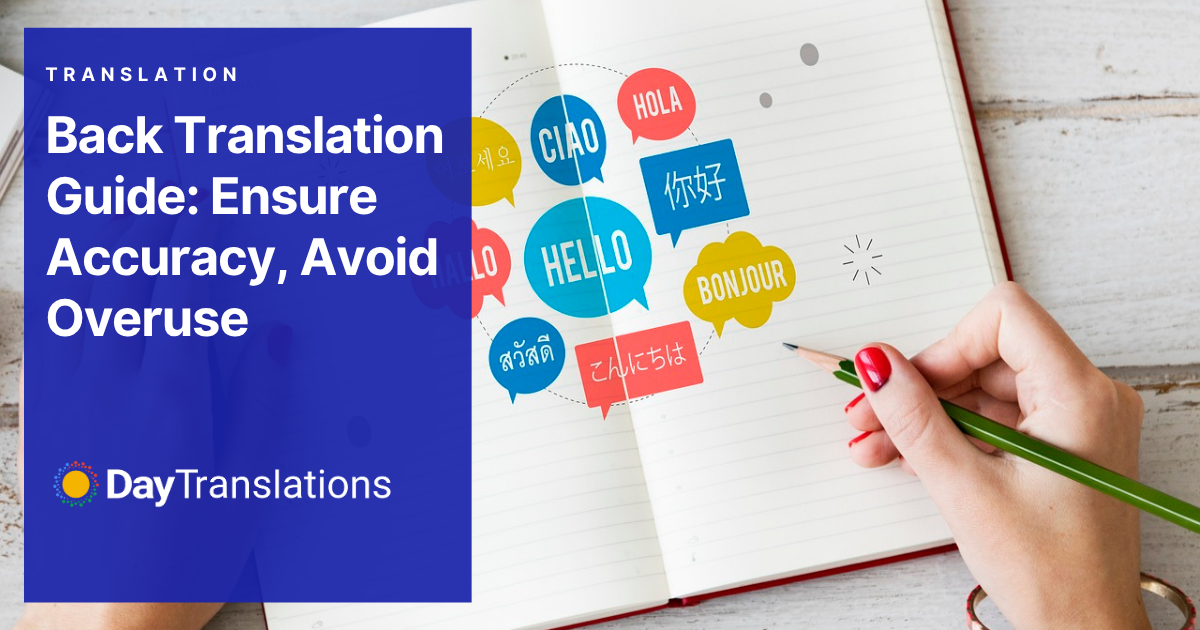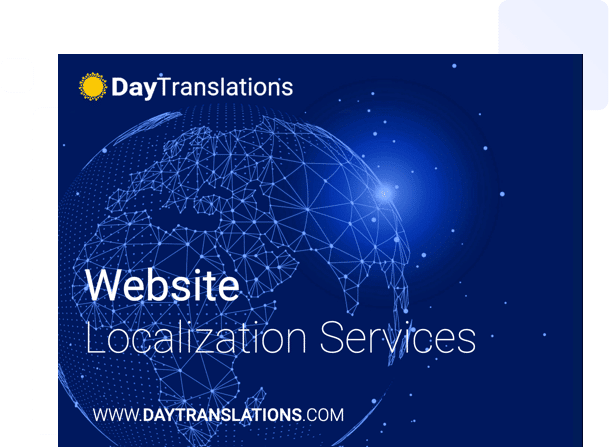When accuracy is critical, back translation can be a powerful tool for validating content that has been translated into different languages. Used widely across the medical, legal, and technical fields, this quality control method involves re-translating a target text back into the source language to uncover potential errors, ambiguities, or cultural mismatches. In this guide, we’ll explain what back translation is, when to use it, and how to apply it effectively.
What Is Back Translation?
Back translation is when a new translator re-translates a text back to the original language without seeing the first version. It helps catch errors and cultural issues, especially in precise fields like healthcare, legal, and engineering.
Why Use Back Translation? Benefits of the Back Translation Method
Back translation is commonly recommended in industry standards and quality assurance guidelines as an effective tool to enhance intercultural communication. It helps reveal subtle differences in meaning and ensures that messages are accurately and clearly conveyed across languages. This is particularly important in fields where even minor translation errors can have serious consequences.
Across sectors, professionals recognize several important advantages of incorporating back translation into quality control processes:
- Spot Shifts in Meaning Before Release: Sometimes even accurate-sounding translations unintentionally alter the intended message. Back translation helps catch these shifts early.
- Maintain Brand Voice Across Languages: Emotional tone and brand personality can get lost in translation. Back translation helps confirm that slogans, UX text, and marketing copy retain their intended voice and impact.
- Prevent Regulatory and Legal Issues: In sectors like healthcare, finance, and legal services, inaccurate translation can lead to non-compliance, liability, or user harm. Back translation provides an added layer of assurance.
- Prevent Expensive Fixes: Back translation helps catch potential problems early in the process, avoiding costly reprints, legal issues, or damage to your brand’s reputation.
- Build Trust with Stakeholders: Clients, regulators, and users expect rigorous quality control, particularly in clinical trials, technical instructions, or legal contracts. A well-documented back translation process demonstrates professionalism and reliability.
When Back Translation Is Essential: Key Industries and Uses
Studies show that in sensitive or regulated fields, back translation is essential for preserving meaning, avoiding confusion, and ensuring accuracy across languages.
Here are some sectors where back translation is particularly important:
| KEY INDUSTRIES AND USES | |
| INDUSTRY | USE CASES |
| Healthcare | Clinical trial protocols and informed consent forms, where patient safety and regulatory standards depend on exact wording. |
| Legal | Contracts, terms and conditions, policy documents, where even small errors can lead to serious legal consequences. |
| Finance | Annual reports, compliance disclosures, where precision is vital for stakeholders and regulatory bodies. |
| Marketing | Slogans, product taglines, brand campaigns, where subtle cultural differences affect how messages are received. |
| Research | Multilingual surveys, academic questionnaires, where consistent language is key to reliable data collection. |
These materials do more than inform. They build trust and protect credibility. For example, in marketing, language shapes emotions and brand identity. In this context, back translation acts as a cultural check, helping preserve tone, humor, and meaning across regions. It is not just a review; it is a smart way to avoid missteps, and support global growth.
Pro Tip: Not everything needs to be back translated. For large projects, focus on the sections that matter most, such as regulatory statements, marketing slogans, or high-visibility content. Supporting text, like footnotes or technical references, can often be reviewed using lighter QA methods. This helps you save time and ensures that you’re directing your resources where they’ll have the greatest impact.
How the Back Translation Method Works: Step-by-Step
Back translation typically follows a clear process to make sure the translated content truly reflects the original message. Many industry experts recommend the following steps:
- Forward Translation: A linguist translates the original content into the target language.
- Back Translation: A second linguist, unfamiliar with the original, translates it back into the source language to provide an unbiased version.
- Comparison: The original and the back-translated texts are compared to spot differences in meaning, tone, or content.
- Reconciliation: Any issues are reviewed and the initial translation is adjusted to better reflect the original message.
This structured process helps maintain clarity and consistency, supporting accuracy in high-stakes content.
How to Get Back Translation Right: Practical Tips
To get the most out of back translation, certain best practices can make a big difference. Numerous specialists and guidelines, like those in the American Translators Association’s Translating for Pharma, often recommend the following:
- Use Different Translators: Make sure the person handling the back translation is not the same one who did the original, to prevent bias.
- Keep It Blind: Don’t show the back translator the original text. This ensures their version stays neutral and independent.
- Stick to the Literal: A more literal translation helps surface errors or shifts in meaning that a freer version might miss.
- Track Issues: Keep a log of any inconsistencies or discrepancies. This helps identify patterns and refine future translations.
Keep in Mind: It’s the message that counts, not the verbal dress code. Use back translation during the comparison stage to catch shifts in meaning and intent, not just word-for-word errors. If tone, style, or emotional impact feel off, back translation helps flag when transcreation or local review is needed to ensure your content resonates across markets.
Lost in Translation: Famous Cases and Lessons Learned
Translation mistakes and localization errors are among the most famous cautionary tales in global marketing. While these stories are often amusing, they also reveal how poor translation choices can harm a brand’s reputation.
The following examples are some of the most widely shared translation blunders across the web and in industry discussions.
Each case illustrates why back translation matters. By translating content back into the original language, linguistic or cultural issues can be uncovered before the message reaches the public.
KFC’s “Finger-Lickin’ Good” Slogan in China
- Original (English): Finger-lickin’ good
- Target Translation (Mandarin): Reportedly mistranslated as 吃掉你的手指 (“Eat your fingers off”)
- Back Translation (Literal): Eat your fingers off
- What Happened: When KFC entered the Chinese market in the 1980s, its playful slogan did not translate well into Mandarin. The back translation revealed a disturbing image that was far from appetizing and clearly not appropriate for the brand.
- Lesson: This error demonstrates that literal accuracy isn’t enough; cultural and linguistic nuance matters. A back translation step could have flagged this mismatch early, prompting a culturally sensitive adaptation of the slogan. The literal back translation, “Eat your fingers off,” exposed both a linguistic error and a culturally jarring phrase that failed to resonate with local consumers.
Parker Pen’s Tagline in Spanish-Speaking Markets
- Original (English): It won’t leak in your pocket and embarrass you.
- Target Translation (Spanish): No gotea en tu bolsillo y te embaraza.
- Back Translation (Literal): It won’t leak in your pocket and make you pregnant.
- What Happened: Parker Pen mistakenly used the Spanish verb embaraza, believing it meant “embarrass,” but it actually means “to impregnate.” This caused a message that was both unintentionally humorous and seriously inappropriate.
- Lesson: This case highlights the risk of false cognates, words that look similar across languages but mean very different things. The back translation process helps catch these traps by showing how a message reads when translated back into the source language. In marketing, where tone and trust are everything, a single word can make or break a campaign.
Nike’s “Just Do It” Across Multiple Languages
- Original (English): Just do it.
- Target & Back Translations:
Spanish: Solo hazlo → Just do it (back translation)
German: Mach es einfach → Do it simply (back translation)
Italian: Fallo e basta → Do it and that’s it (back translation)
- What happened: Nike’s iconic slogan largely survived intact in Spanish. However, in German and Italian, subtle shifts in tone crept in. Mach es einfach softens the message to “do it simply,” while Fallo e basta adds a slightly different nuance: “do it and that’s it.”
- Lesson: Even when no obvious errors occur, back translation can reveal tone shifts that affect a brand’s emotional voice. Slogans and taglines depend heavily on tone, pacing, and rhythm. A back translation review helps ensure that the intended impact such as confidence, energy, and motivation remains consistent across markets.
Before You Hit Send
The famous cases we’ve explored are more than just entertaining anecdotes. They are reminders of how easily translation missteps can undermine a brand’s message and reputation.
Back translation is not the only quality control tool, but when used thoughtfully, it adds an important layer of protection. It helps uncover hidden risks in tone, meaning, and cultural fit before a message goes live. It also supports consistency across languages and markets, ensuring that translations do more than simply match words. They must resonate with the audience.
In global marketing, what you miss before launch can become tomorrow’s cautionary tale. Back translation helps make sure your message is remembered for the right reasons.
When Back Translation Isn’t the Best Fit: Limitations and Alternatives
Back translation is a well-established quality assurance method in translation projects. It verifies accuracy by translating a text back into the original language to spot errors or meaning shifts.
However, back translation isn’t always the best fit for every project. Understanding its limitations—highlighted by researchers like Dorothée Behr, among others—helps teams choose more effective quality checks based on the context. Below are common situations where back translation may fall short, along with alternative strategies to consider:
Creative Content
- Limitations: Back translation is effective at catching shifts in meaning and intent. As noted earlier, the goal is to ensure the message, not just the words, comes through clearly. However, it struggles with tone, cultural nuance, and emotional resonance, which are key elements in creative materials like marketing campaigns, literary works, or slogans. These factors are essential for how audiences emotionally connect with your message.
- Try this instead: For creative projects, back translation works well as an initial check to identify potential issues. To fully capture nuance and cultural relevance, it is often better to complement or replace it with transcreation or local cultural review. These can ensure that your message resonates deeply while maintaining brand consistency across markets.
Tight Turnarounds
- Limitations: Back translation adds additional steps to the translation process, increasing the total time needed to complete a project. This delay can be problematic for projects with urgent deadlines or rapid release cycles.
- Try this instead: Opt for bilingual review or in-country review. In these approaches, a skilled bilingual expert compares the translation directly with the source text to identify discrepancies more quickly. This method reduces time without sacrificing critical quality checks.
Limited Resources
- Limitations: Back translation requires more resources, including qualified translators and reviewers who can handle both forward and backward translations. Smaller budgets or limited access to experienced linguists can increase the risk of errors slipping through due to rushed or inadequate checks.
- Try this instead: Implement focused quality checks such as terminology consistency reviews, glossaries, and automated QA tools. Combining these with sample audits of critical segments can optimize quality assurance within constrained resources.
Choosing the Right QA Approach
Picking the best quality assurance method depends on your project’s goals, the type of content, deadlines, and available resources. By mixing and matching strategies wisely, you can achieve both accuracy and efficiency without losing the clarity your audience needs.
Here’s a handy comparison to help you decide which QA method fits your project best:
| COMPARISON TABLE OF COMMON QA METHODS FOR TRANSLATION | ||||
| METHOD | BEST FOR | STRENGTHS | LIMITATIONS | WHEN
TO USE |
| Back Translation | Legal, medical, regulated texts | Catches literal errors and meaning shifts | Time-consuming, misses tone | Critical, sensitive content |
| Transcreation | Marketing, branding, creative | Preserves tone, style, and emotion | Less focus on literal accuracy | Creative campaigns needing local flavor |
| Bilingual Review | Tight deadlines, moderate complexity | Fast, efficient, catches errors in meaning | Needs skilled bilingual reviewers | Fast turnaround with moderate QA |
| In-Country Review | Localization, cultural adaptation | Ensures cultural relevance | Depends on local expert availability | Projects targeting specific locales |
| Terminology Checks and Automated QA | Large volumes, tight budgets | Cost-effective, consistent, quick error detection | May miss subtle errors | High-volume or budget-
sensitive projects |
Remember: Quality assurance isn’t one-size-fits-all. Think of back translation as your accuracy anchor, but when speed, style, or savings matter, it’s time to sail with agile reviews and clever tools.
Editor’s Note: Back Translation — A Safety Net
I was recently tasked with translating a scholarly article for an academic journal. The piece explored the works of Chilean writer Nona Fernández and required an English translation that resonated with an international readership. Given its literary nature, translating this content required more than mere word-for-word accuracy.
I knew it was common practice for the journal’s editor to request a back-translation of unclear segments to better assess translation choices. In my case, this didn’t happen, which was a relief, considering the liberties I took to ensure natural phrasing and clarity over strict literalism.
Lessons in Bridging Meaning
This experience gave me two lasting insights that continue to shape my approach today:
- Translation Demands Courage: as scholars like Ortega y Gasset, Redondo-Olmedilla, and Rabassa suggest, translators must at times challenge rigid linguistic norms to preserve meaning and nuance, shedding timidity to confront the constraints of grammar and convention with boldness. The editor’s silence only reinforced this idea. It was a quiet confirmation that making bold adjustments doesn’t mean the translation is flawed.
- Daring Moves Blur the Lines: Sometimes, boldness in translation as an active form of artistry merges tasks and roles into a single organic entity: the translator. Although theory distinguishes QA methods and roles like translator and transcreator, in practice, the boundaries are often fluid. Bold decisions can blur these lines, revealing how frequently translators take on multiple responsibilities. Creative translation demands adaptation, interpretation, and stylistic precision to echo the thought-provoking insights of scholars in the field. In this case, the blending of translation and transcreation revealed the fluid nature of the process, showing how roles naturally intertwine in practice.
Ultimately, while back translation sometimes provides an essential external checkpoint, the ultimate test of quality often happens within, where the translator’s expertise and intuition refine meaning beyond mere transfer.
In the end, we translators are dynamic creatures, shifting with the tides of content, and safeguarded by back translation, our trusted insurance against error.
Back Translation Checklist: Ensure a Reliable Process
Common practice across translation research highlights several important steps for reliable back translation:
- Engage a Different Translator
Assign the back translation to a linguist who was not involved in the initial translation. This separation helps maintain impartiality and minimizes unconscious influence from the original wording.
- Maintain Translator Blindness
Ensure the back translator does not have access to the original source text. This encourages a translation that reflects only what was conveyed in the target language, helping to reveal unintended shifts in tone or meaning.
- Prioritize Faithfulness Over Fluency
The back translator should focus on conveying the exact meaning and structure of the translation, avoiding rephrasing or polishing. This helps highlight any shifts or inconsistencies between versions. The goal is to reveal any differences or errors, so the translation should not be smoothed out or adapted for style or flow.
- Record Discrepancies Systematically
Use shared tools to log all differences in terminology, nuance, and style. Categorizing these inconsistencies allows teams to detect patterns that may indicate broader issues in specific content areas or markets.
- Resolve Differences Collaboratively
Compare the back translation with the original side-by-side. Involve the original translator and reviewers to discuss discrepancies and make informed decisions that best preserve the source intent.
| GOOD VS. POOR BACK TRANSLATION PROCESS | ||
| PROCESS STEP | EFFECTIVE PRACTICE | INEFFECTIVE PRACTICE |
| Translator Selection | Uses separate, independent linguists unfamiliar with the source text. | Reuses the same translator, increasing the risk of bias or carried-over errors. |
| Translation Method | Follows a more literal approach to better expose discrepancies. | Relies on interpretive translation, potentially obscuring issues. |
| Comparison | Conducts a structured analysis to identify shifts in meaning or tone. | Lacks a formal review or relies on assumptions. |
| Reconciliation | Resolves discrepancies based on clear documentation and discussion. | Accepts the initial translation without further scrutiny or adjustment. |
Closing Remarks
Back translation stands out as a powerful quality assurance method when precision and clarity are non-negotiable. It not only uncovers hidden shifts in meaning but also safeguards brand voice and compliance across languages, making it indispensable in regulated industries like healthcare, legal, and finance, while also supporting tone and brand consistency in marketing.
However, it’s not a one-size-fits-all solution; understanding when to use it or when to rely on alternatives like transcreation or bilingual review (or, when luck strikes, a translator who’s both fearless and culturally embedded in the target language and its nuances) ensures your content is both accurate and culturally resonant without unnecessary delays or costs.
Ultimately, the true value of back translation lies in its ability to bridge linguistic and cultural gaps before your message reaches a global audience, turning potential pitfalls into opportunities for trust and connection. So, whether you’re navigating clinical trials or crafting a catchy slogan, back translation reminds us that in translation, sometimes looking back is the best way to move forward.













Sorry, the comment form is closed at this time.